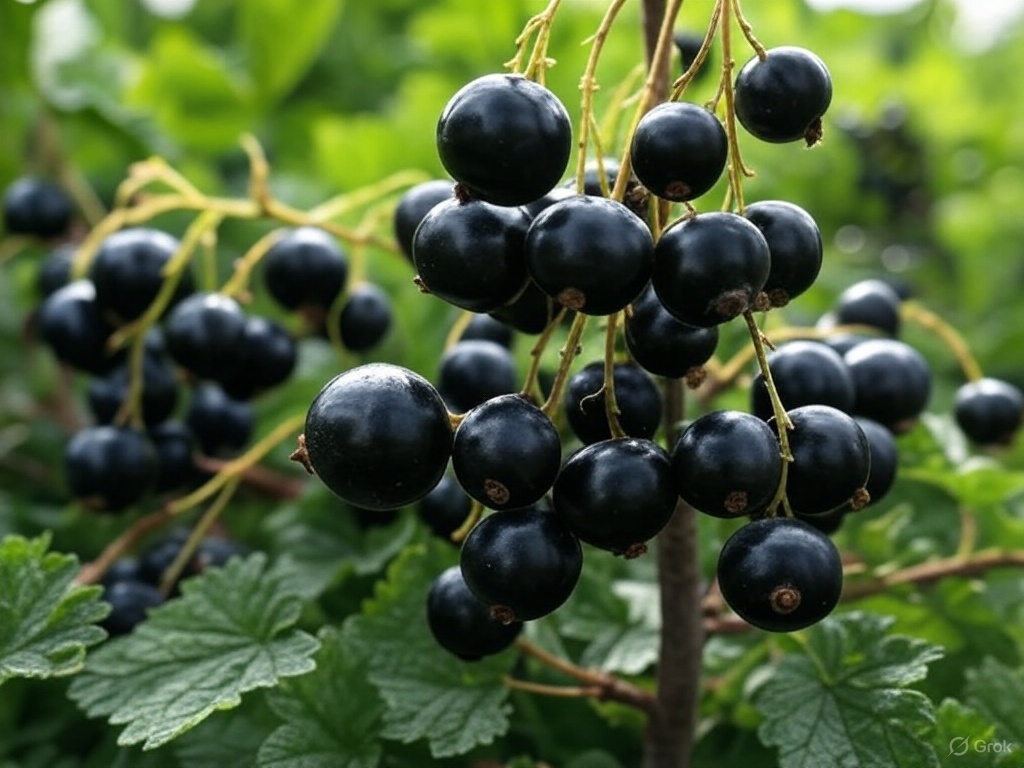
Black currants (Ribes nigrum) are small, dark berries packed with flavor and nutrition, and they have a wide range of uses across culinary, medicinal, and even cosmetic applications. Here’s a detailed breakdown of their uses:
Culinary Uses
Black currants have a tart, slightly sweet flavor, making them versatile in both sweet and savory dishes. They’re often used in:
- Jams, Jellies, and Preserves
- Black currants are a classic ingredient for jams and jellies due to their high pectin content, which helps them set naturally. They’re often combined with sugar to balance their tartness.
- Desserts
- They’re popular in pies, tarts, cakes, and crumbles. For example, black currant compote can be used as a topping for cheesecakes or ice cream.
- They can also be incorporated into muffins, scones, or fruit breads.
- Beverages
- Black currants are a key ingredient in the famous French liqueur Crème de Cassis, often used in cocktails like the Kir Royale (mixed with champagne).
- They’re also used to make juices, cordials, teas, and smoothies. In the UK, black currant cordial (like Ribena) is a popular drink.
- Some craft breweries and winemakers use black currants to create fruit beers or wines.
- Sauces and Savory Dishes
- Black currants can be made into sauces or reductions to accompany meats like duck, venison, or pork. The tartness complements the richness of game meats.
- They can also be added to chutneys or used in marinades.
- Dried or Frozen
- Dried black currants are used in trail mixes, granola, or as a snack. Frozen black currants are great for smoothies or baking when fresh ones aren’t available.
Medicinal and Health Uses
Black currants are a nutritional powerhouse, rich in vitamin C, antioxidants (especially anthocyanins), and other beneficial compounds. They’ve been used in traditional medicine for centuries and are still valued for their health benefits:
- Immune Support
- With up to 181 mg of vitamin C per 100 grams (over 200% of the daily recommended intake), black currants are excellent for boosting the immune system and fighting off colds or infections.
- Anti-Inflammatory and Antioxidant Properties
- The anthocyanins in black currants have strong anti-inflammatory effects, which may help reduce the risk of chronic diseases like heart disease and cancer.
- They also protect against oxidative stress, supporting overall cellular health.
- Eye Health
- Black currants contain gamma-linolenic acid (GLA) and anthocyanins, which may improve blood flow to the eyes, reduce symptoms of glaucoma, and support vision health. During World War II, British pilots reportedly consumed black currant jam to improve night vision.
- Cardiovascular Health
- The antioxidants and potassium in black currants can help lower blood pressure, reduce cholesterol levels, and improve heart health.
- Skin and Joint Health
- Black currant seed oil, rich in GLA and omega-3 fatty acids, is often used to reduce symptoms of rheumatoid arthritis, eczema, and other inflammatory skin conditions.
- Traditional Remedies
- In herbal medicine, black currant leaves are used to make teas or infusions to treat sore throats, urinary tract infections, and diarrhea. The berries themselves are sometimes used as a natural diuretic.
Cosmetic and Skincare Uses
Black currant seed oil and extracts are popular in the beauty industry due to their nourishing properties:
- Skincare Products
- The oil is used in creams, serums, and lotions for its moisturizing and anti-aging effects. Its fatty acids help repair the skin barrier, while antioxidants combat free radical damage.
- It’s particularly beneficial for dry or sensitive skin, and some studies suggest it can help with conditions like psoriasis or eczema.
- Hair Care
- Black currant oil is sometimes added to shampoos or hair masks to promote hair growth and improve scalp health, thanks to its anti-inflammatory properties.
Agricultural and Ornamental Uses
- Gardening
- Black currant bushes are grown in home gardens or commercially for their fruit. They’re hardy plants that thrive in cooler climates and can be a great addition to a permaculture setup.
- The bushes also have ornamental value with their attractive foliage and clusters of berries.
- Companion Planting
- Some gardeners plant black currants near other crops because they may help deter certain pests with their strong scent.
Other Uses
- Natural Dye
- The deep purple-black color of black currants makes them a natural choice for dyeing fabrics or creating food coloring.
- Animal Feed
- In some regions, black currant pomace (the leftover pulp after juicing) is used as a nutritious supplement for livestock feed.
Cultural and Historical Significance
- Black currants have a rich history, especially in Europe. In the UK, they became popular during World War II when citrus fruits were scarce, and the government encouraged black currant cultivation for their high vitamin C content.
- In some cultures, black currants are associated with longevity and vitality due to their health benefits.
A Note on Availability
In the United States, black currants were banned for much of the 20th century because they were thought to spread a fungus (white pine blister rust) that harmed pine trees. The federal ban was lifted in 1966, but some states still have restrictions. This is why black currants are less common in the U.S. compared to Europe, though they’re making a comeback as people rediscover their value.
Quick Recipe Idea: Black Currant Compote
- Ingredients: 1 cup fresh or frozen black currants, 1/4 cup sugar (adjust to taste), 1 tbsp lemon juice, 1/4 cup water.
- Method: Simmer the black currants, sugar, and water in a saucepan over medium heat for 10-15 minutes until the berries break down and the mixture thickens. Stir in the lemon juice and let it cool. Use as a topping for yogurt, pancakes, or desserts.
Black currants are incredibly versatile, so whether you’re cooking, looking for natural health remedies, or experimenting with skincare, they’re a fantastic ingredient to explore! Do you have a specific use in mind?
